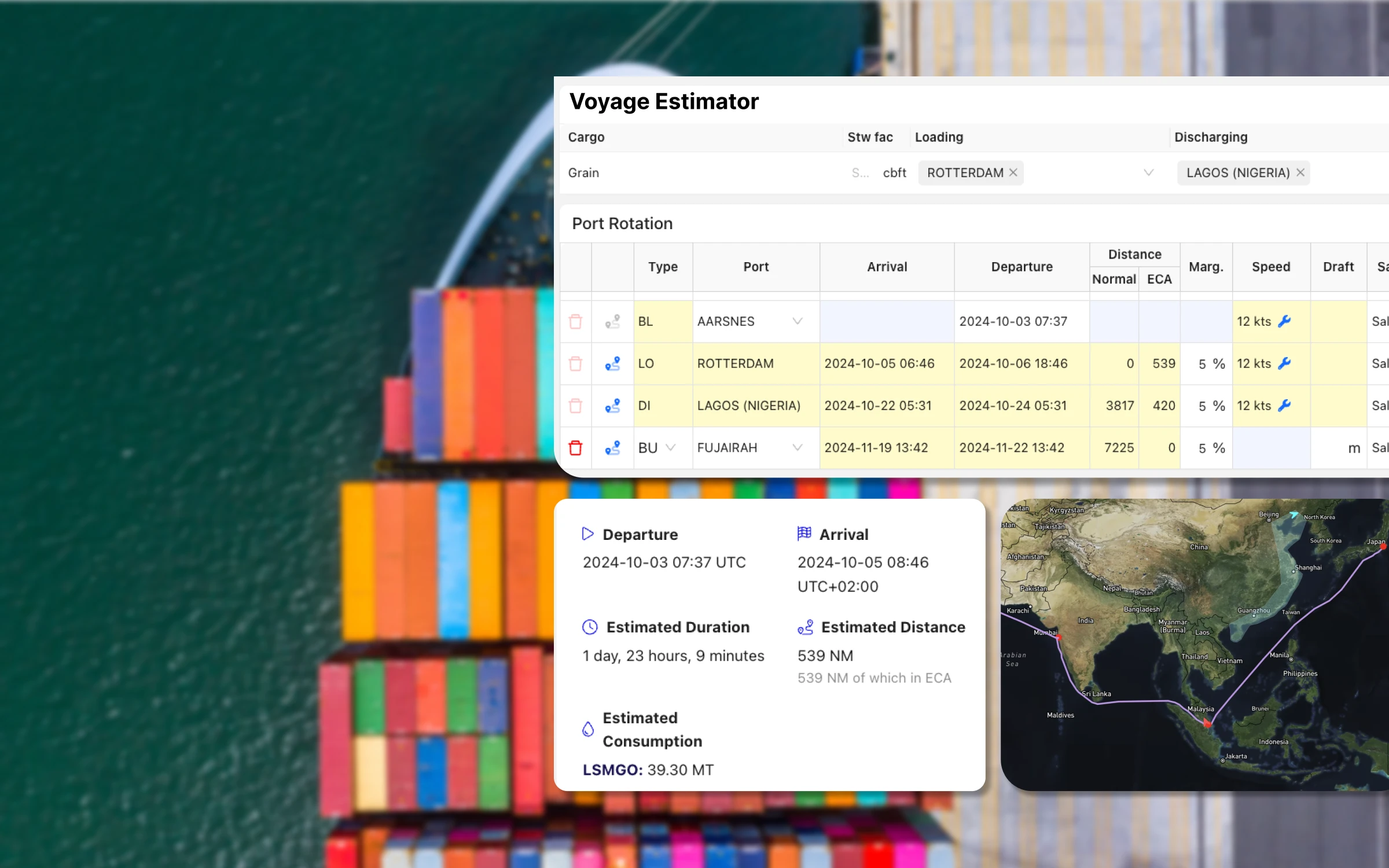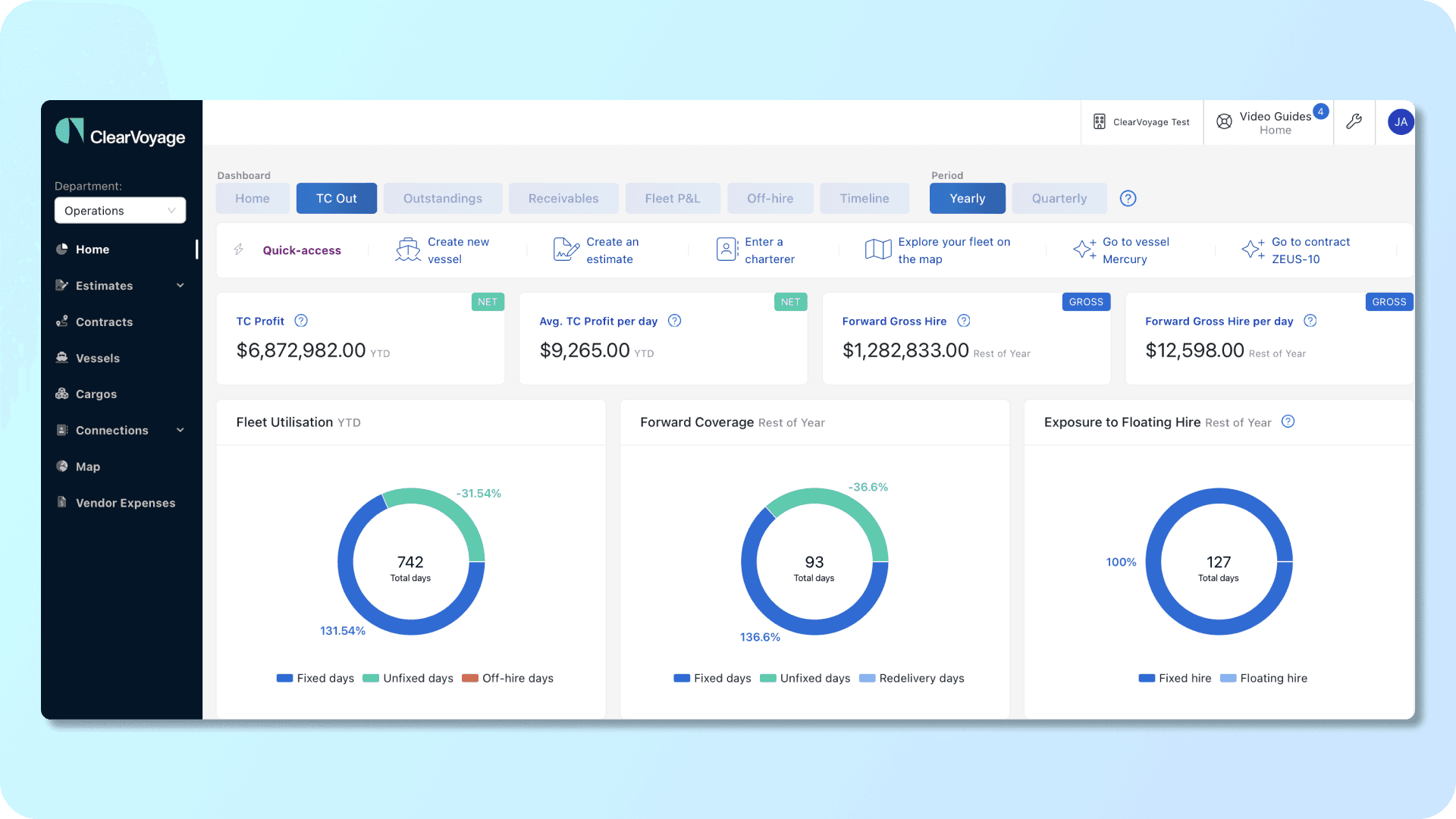Oct 9, 2024
In the shipping industry, accurate voyage estimation is critical for profitability and operational success. Whether you're moving crude oil, coal, or containerized goods, knowing your voyage costs, potential profits, and voyage duration is key to running an efficient shipping business.
But what exactly is voyage estimation? How do you perform it accurately? And is Excel still the best way to do it, or should you be considering more advanced voyage estimating systems?
In this guide, we'll walk you through the entire process, from understanding what a voyage estimator does to providing a detailed voyage estimation calculation example. We'll also discuss why switching to a more sophisticated voyage management system, like ClearVoyage, is the smarter choice over Excel spreadsheets.

What is a Voyage Estimator?
A voyage estimator, or sometimes called a pre-voyage calculation is a way to calculate the financial and logistical aspects of a maritime voyage. In its simplest form, this involves estimating the revenues, costs, and profits of a voyage.
A well-performed voyage estimation can provide shipping companies with key insights, helping them:
Maximize profitability
Understand operational costs
Make informed decisions about vessel routes and schedules
Negotiate better charter contracts
Voyage estimation requires balancing several variables, such as bunker (fuel) prices, port expenses, weather forecasts, and freight rates. Given how much is at stake, using accurate and reliable tools for voyage estimating is crucial for shipping companies.

Components of Voyage Estimation
When performing a voyage estimation, several factors must be taken into account. These include:
1. Freight Revenue
This is the total income expected from transporting goods between two points. The freight rate can be influenced by market conditions, the type of cargo, and the distance of the voyage.
2. Bunker Costs
Fuel (bunker) is one of the biggest costs in maritime shipping. To estimate this cost accurately, you need to know the fuel consumption rate of the vessel and the current prices for different types of fuel (such as heavy fuel oil or marine diesel).
3. Port Costs
Each port has its own set of charges, which can include docking fees, pilotage, towage, and cargo handling fees. Estimating port costs for all the stops on your route is essential.
4. Canal Costs
If the vessel is passing through canals like the Suez or Panama, there will be additional fees. These need to be included in the estimation as they can significantly impact profitability.
5. Weather Conditions
Weather conditions can affect fuel consumption and the overall duration of the voyage. Rough seas, strong winds, or ice can delay the vessel and increase bunker consumption.
6. Voyage Duration
The length of time it takes to complete a voyage directly affects the profitability of a ship. A longer voyage means more fuel consumption and operational expenses. Voyage duration also includes potential waiting times at congested ports or canals.
7. Other Operational Costs
Other variables like insurance, maintenance, crew wages, and even piracy risk premiums must be factored in.
Once all these factors are considered, a voyage estimation calculation can be performed to assess the voyage’s overall profitability.
Voyage Estimation Calculation Example
To better understand how this works, let’s go through a simplified voyage estimation calculation example.
Scenario:
Vessel: Supramax bulk carrier
Route: New Orleans to Rotterdam
Cargo: 50,000 metric tons of coal
Freight Rate: $10 per metric ton
Bunker Consumption: 30 metric tons/day at sea, 5 metric tons/day in port
Bunker Price: $400/metric ton
Port Costs: $50,000 (New Orleans), $75,000 (Rotterdam)
Canal Fees: None (No canal transit in this route)
Weather Delay: Estimated additional 2 days due to rough seas
Voyage Duration: 25 days (sea) + 3 days (port) + 2 days (weather delay)
Step-by-Step Calculation:
Freight Revenue = 50,000 MT × $10/MT = $500,000
Bunker Cost at Sea = 25 days × 30 MT/day × $400/MT = $300,000
Bunker Cost in Port = 3 days × 5 MT/day × $400/MT = $6,000
Total Bunker Cost = $300,000 + $6,000 = $306,000
Port Costs = $50,000 (New Orleans) + $75,000 (Rotterdam) = $125,000
Total Voyage Cost = Bunker Cost + Port Costs = $306,000 + $125,000 = $431,000
Profit = Freight Revenue - Total Voyage Cost = $500,000 - $431,000 = $69,000
In this example, the voyage would yield a profit of $69,000. While this is a basic estimation, in reality, the process can be far more complex. Variables like additional insurance, maintenance, and other unforeseen expenses can come into play.
Limitations of Voyage Estimation in Excel
Many shipping companies still use Excel for voyage estimation calculation. Excel is a powerful tool for basic calculations, and it's widely accessible. However, relying solely on spreadsheets can lead to several limitations:
1. Risk of Human Error
The most significant limitation of using Excel is the risk of human error. Simple typos or formula mistakes can drastically affect the outcome of a voyage estimation, potentially leading to wrong decisions.
2. Lack of Real-Time Data
Shipping is highly dynamic, with fuel prices, weather conditions, and freight rates changing frequently. Excel doesn’t update automatically, meaning your estimations could quickly become outdated unless manually refreshed with the latest data.
3. Difficulty in Managing Complex Voyages
For more complex voyages involving multiple stops, varying cargoes, or changing fuel prices, Excel can become unwieldy. Creating sophisticated voyage estimating systems in Excel often involves advanced knowledge of formulas, pivot tables, and VBA (Visual Basic for Applications).
4. Limited Collaboration
In larger shipping companies, multiple people may need to work on the same voyage estimation. Sharing and updating Excel files across teams can lead to confusion, duplicate versions, and inconsistencies.
5. Inefficient for Large-Scale Operations
For shipping companies managing dozens of vessels, using Excel becomes increasingly inefficient. The time spent manually inputting data and updating estimates can slow down operations.
The Case for Using Voyage Estimating Systems
Given the limitations of Excel, many shipping companies are turning to dedicated voyage estimating systems like ClearVoyage. These specialized software platforms offer several advantages over traditional spreadsheets:
1. Automation of Calculations
Voyage estimating systems like ClearVoyage can automate most of the calculations involved in voyage estimation. From bunker costs to port fees, the system pulls in real-time data and applies it to your voyage plan, reducing the chance of human error.
2. Real-Time Data Integration
Instead of relying on static numbers in Excel, these systems can integrate real-time market data, including updated fuel prices, freight rates, and even weather forecasts. This ensures that your voyage estimation remains accurate and up-to-date.
3. Scenario Planning
Want to test different routes or cargo types? Voyage estimating systems allow you to easily create multiple voyage plans and compare the results. This is difficult and time-consuming to do in Excel.
4. Collaboration & Workflow Management
With ClearVoyage, multiple stakeholders can work on the same voyage estimation simultaneously. This feature eliminates version control issues and streamlines collaboration between different teams.
5. Historical Data for Better Decision-Making
ClearVoyage and other voyage estimating systems allow you to store and analyze historical voyage data. This gives you valuable insights into past performance and helps with future forecasting and budgeting.
6. Time-Saving
Ultimately, using a dedicated system is a massive time-saver. While Excel requires manual data entry and formula setup, voyage estimating systems do most of the heavy lifting for you, freeing up time to focus on strategic decision-making.
Switching from Excel to a VMS
If you're still using Excel for your voyage estimation calculation, it may be time to consider upgrading to a more efficient system. Tools like ClearVoyage offer advanced functionality, real-time data integration, and automation features that Excel simply can't match. These systems allow you to minimize errors, save time, and make more informed decisions.
With ClearVoyage, you can:
Access real-time fuel prices and freight rates
Collaborate seamlessly across teams
Run scenario comparisons for different routes
Analyze historical voyage data to optimize future voyages

ClearVoyage helps you take control of your voyage estimating process, ensuring that you're making the most profitable decisions with minimal effort.
Ready to revolutionize your voyage estimation process? Try ClearVoyage today and see how it can save you time and boost your bottom line.
